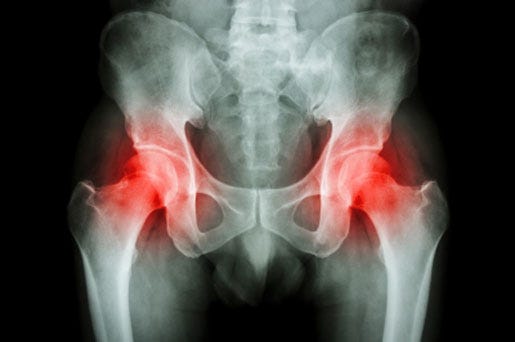Why Metal-on-Metal Implants Are Really Scary
June 23, 2016
Study finds that dissolved metal ions from the implants infused bone marrow.
Nancy Crotti

Scientists have known for years that shards released by metal-on-metal hips can cause bone loss. Now European researchers have discovered how and are urging "critical reconsideration" of the metal alloys in artificial hips.
Chromium and cobalt ions released into patients' bodies by these hip implants impair the predecessors of bone-forming cells, according to the study by physicians and researchers from Charité - Universitätsmedizin Berlin and DRK Klinikum Westend. The results appear in the current edition of the journal Biomaterials.
The researchers tested adjacent tissues, joint fluids, and bone marrow, looking for changes that might be triggered by exposure to chromium and cobalt. While much of the focus on these devices is on shards of metal, these scientists found that dissolved metal ions reached the bone marrow, where they inhibited bone mineralization, according to a statement from the researchers.
They had identical results from exposing cell cultures derived from non-exposed patients to a relevant level of dissolved chromium and cobalt.
"Local exposure assessment represents a significant contribution in our quest to better understand the biological responses to metal wear, and helps to identify causations of implant failure," said researcher Anastasia Rakow, MD, from Charité's Center for Musculoskeletal Surgery, in the statement.
"According to our research, the products of corrosion and wear are caused by multiple factors," added Janosch Schoon, researcher at the Julius Wolff Institute and member of the German Society of Toxicology. "The properties of the materials involved play a central role, as do biomechanical and anatomical factors specific to the individual patient. We need a systematic approach if we intend to be able to adequately estimate actual exposure levels arising from the various metals used in hip implants."
Introduced in the late 1990s, all-metal implants were thought to be stronger than other types of implants, with the exception of those made of ceramic, which are hard, yet brittle. Manufacturers including Johnson & Johnson, Stryker, and Zimmer Biomet, jumped onto the metal-on-metal bandwagon.
The implants had serious issues. In addition to harming bone, chromium and cobalt ions released by the implants can seep into tissue and destroy muscle as well. If these ions manage to enter a patient's circulatory system, they can injure the kidneys, liver, spleen, and lymph nodes before elimination from the body through urine. Patients have alleged that the devices cause chromium poisoning, cobalt poisoning, tissue necrosis, and pseudotumors.
Manufacturers have settled scores of lawsuits over the devices, totaling into the billions of dollars.
Nancy Crotti is a contributor to Qmed.
Like what you're reading? Subscribe to our daily e-newsletter.
[Image courtesy of STOCKDEVIL/FREEDIGITALPHOTOS.NET]
About the Author(s)
You May Also Like


